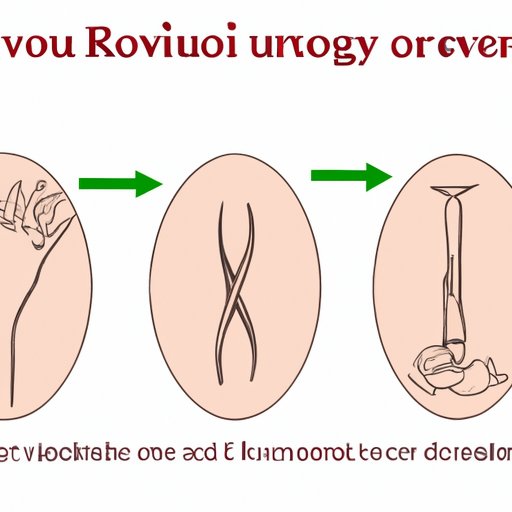
I. Introduction
Uterus removal or a hysterectomy is a surgical procedure where the uterus is removed. Hysterectomy can be performed through abdominal, vaginal, or laparoscopic methods. There are different indications for removal, and women typically consider it when facing various conditions that affect the uterus. This article will explore when women consider uterus removal, the procedure and recovery, alternatives to the procedure, as well as the emotional impact of the procedure.
II. The Pros and Cons of Uterus Removal
A. Benefits of Uterus Removal
Women face numerous conditions that may require the removal of the uterus. One of the most common reasons is fibroids. Fibroids are an overgrowth of non-cancerous muscle cells present in the uterus. One of the most effective treatment options for fibroids is a hysterectomy, which can relieve symptoms such as heavy bleeding, severe menstrual cramps, and pressure in the pelvic area.
Women with endometriosis can also benefit from a hysterectomy. Endometriosis is a condition where the lining of the uterus grows outside the uterus. This can lead to extreme pain, scarring, and infertility. A hysterectomy can remove the uterus and, with it, the pain-causing tissue.
Cancer or precancerous conditions may also require a hysterectomy. In such cases, the surgeon may additionally remove the ovaries, cervix, and fallopian tubes.
B. Risks and Possible Complications of the Procedure
As with any surgical procedure, a hysterectomy carries risks and possible complications. These can include:
- Blood clots
- Infection
- Excessive bleeding
- Urinary Incontinence
- Pelvic pain and discomfort
- Early menopause symptoms after surgery
Women should discuss these possible complications with their healthcare provider extensively. It is essential to weigh the risks versus benefits to make informed decisions.

III. Uterus Removal: Understanding the Procedure and Recovery Process
A. Explanation of How the Procedure is Performed
A hysterectomy can be performed through different methods, including vaginal, laparoscopic, and abdominal. The appropriate type of procedure for the patient depends on factors such as the size and position of the uterus, whether there have been previous surgeries and complications, and the patient’s general health.
In a vaginal hysterectomy, the uterus through the vagina is removed. During a laparoscopic surgery, the procedure is performed through tiny incisions using a camera and surgical instruments. An abdominal hysterectomy, on the other hand, involves making a large incision in the lower abdomen. The uterus is removed through the incision.
B. Recovery Process and Tips for a Smooth Recovery
The recovery process differs between patients but takes about four to six weeks. After surgery, women may experience discomfort and pain that can last up to a week. Doctors will typically prescribe pain relievers for this period. As physical activity may exacerbate the pain, women are advised to rest as much as possible during this period.
As with any surgical procedure, women who have undergone a hysterectomy are at risk of developing blood clots. The risk of developing clots can be reduced by staying active and performing low-impact exercises such as walking daily.
Women need to listen to their bodies while recovering from the procedure. If they have any extreme pain, high fever, or heavy bleeding, calling the doctor immediately is essential.
IV. When to Consider Uterus Removal: Signs and Symptoms to Watch For
A. Explanation of Conditions That May Require Uterus Removal
Several conditions require the removal of the uterus. One of the most common conditions is fibroids. Symptoms of fibroids include heavy bleeding, pelvic pressure, and severe menstrual cramps. Endometriosis occurs when the lining of the uterus grows outside the uterus. Symptoms include pelvic pain, infertility, and heavy periods.
If medication or other treatments fail to control the symptoms, a hysterectomy may be recommended. Other conditions include cancer, uterine prolapse, and abnormal or heavy bleeding caused by fibroids or other conditions.
B. Signs and Symptoms That Should Prompt Discussion with a Doctor
Women who experience any of the following symptoms should discuss their options with their doctor:
- Heavy or prolonged menstrual bleeding
- Chronic pelvic pain
- Pain during intercourse
- Difficulty emptying the bladder
- Unusual vaginal discharge
V. The Emotional Impact of Uterus Removal: Coping with the Loss of Fertility
A. Emotions That Women May Experience After a Hysterectomy
A hysterectomy can be an emotional decision. Women may feel anxious, sad, or depressed after the procedure. It is common for women to experience a sense of loss or a feeling that something is missing after the procedure. Women who experience severe emotional discomfort after the procedure should speak with a mental health counselor.
B. Coping Mechanisms and Support Options
It is essential for women who have undergone a hysterectomy to seek a support network. This can be through talking with family or friends, participating in support groups, or online communities. Women should also make time for self-care and be kind to themselves during the recovery period.
VI. Alternatives to Uterus Removal: Exploring Other Treatment Options
A. Non-Surgical Treatment Options for Conditions Requiring a Hysterectomy
Women who have been recommended for a hysterectomy may want to explore other treatments before proceeding with the procedure. Medications such as gonadotropin-releasing hormone (GnRH) can help reduce the symptoms for women with endometriosis or fibroids. These medications work by decreasing the production of estrogen temporarily, which the fibroids and endometriosis need to grow. Fibroids can also be removed using myomectomy, where the fibroids are removed, allowing the uterus to remain.
B. Risks and Benefits of Alternative Treatments
Alternative treatments can carry risks and benefits that women should consider. Medications such as GnRH can only be used for a specific time and can cause menopause symptoms such as hot flashes. Myomectomy leaves the uterus intact, but there is a chance fibroids can grow back.
VII. Uterus Removal and Hormone Therapy: What Women Should Consider
A. Explanation of the Role of Hormones in Recovery
After a hysterectomy, women may experience the onset of menopause symptoms. Since the ovaries can be affected during surgery, the body may not produce enough estrogen. Hormone therapy can help replace estrogen and relieve symptoms such as hot flashes, night sweats, and vaginal dryness.
B. The Benefits and Risks of Hormone Therapy After a Hysterectomy
Women need to discuss the risks and benefits of hormone therapy with their doctor. Estrogen replacement therapy is known to decrease the risks of osteoporosis and colon cancer. On the other hand, there is a possible increased risk of developing breast and endometrial cancer. Women should discuss with their doctor their family history, personal medical history, and lifestyle factors before deciding if hormone therapy is an appropriate choice for them.
VIII. Myths and Misconceptions About Uterus Removal: Separating Fact from Fiction
A. Debunking Common Myths and Misconceptions
One of the most common myths is that a hysterectomy will lead to weight gain. Studies show that although changes in body composition may occur after a hysterectomy, these changes may be temporary and not lead to significant weight gain. Another common misconception is that a hysterectomy will increase the risk of urinary incontinence later in life. However, studies have found that the risk of incontinence reducing after a hysterectomy in some cases.
B. Evidence-Based Information on the Procedure and Recovery Process
Women should always seek evidence-based information on the procedure and the recovery process from reputable sources such as health care professionals or government health agencies. Patients should also engage in open communication with their care provider, with regards to their recovery process, complications and scars in the incision site and other transitional issues associated with the surgery.
IX. Conclusion
of Key Takeaways
A hysterectomy is an option for women facing specific conditions that affect the uterus, such as fibroids, endometriosis, cancer, and prolapse. Women considering a hysterectomy must discuss all their options with their health care provider. They must weigh the benefits against the risks and discuss any possible alternative treatments if they are available.
B. Call to Action for Women to Discuss Options With Their Healthcare Provider
Women should always make an informed decision with their healthcare providers before considering hysterectomy based on their specific medical condition and unique body needs. They must also prepare emotionally and mentally with the support of their loved ones and resources that are available to them.





